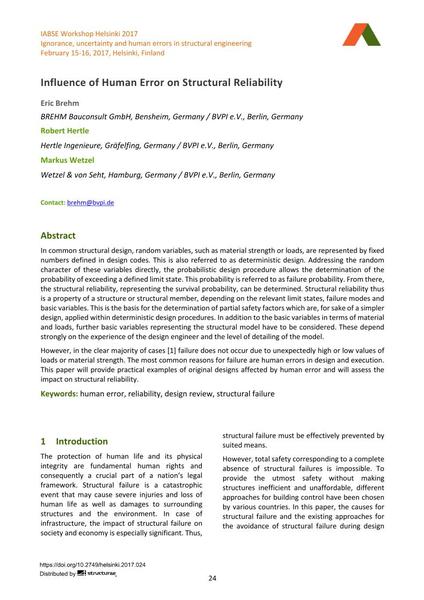Influence of Human Error on Structural Reliability

|
|
|||||||||||
Bibliografische Angaben
| Autor(en): |
Eric Brehm
(BREHM Bauconsult GmbH, Bensheim, Germany / BVPI e.V., Berlin, Germany)
Robert Hertle (Hertle Ingenieure, Gräfelfing, Germany / BVPI e.V., Berlin, Germany) Markus Wetzel (Wetzel & von Seht, Hamburg, Germany / BVPI e.V., Berlin, Germany) |
||||
|---|---|---|---|---|---|
| Medium: | Tagungsbeitrag | ||||
| Sprache(n): | Englisch | ||||
| Tagung: | IABSE Workshop: Ignorance, Uncertainty, and Human Errors in Structural Engineering, Helsinki, Finland, 15-16 February 2017 | ||||
| Veröffentlicht in: | IABSE Workshop Helsinki 2017 | ||||
|
|||||
| Seite(n): | 24-30 | ||||
| Anzahl der Seiten (im PDF): | 7 | ||||
| DOI: | 10.2749/helsinki.2017.024 | ||||
| Abstrakt: |
In common structural design, random variables, such as material strength or loads, are represented by fixed numbers defined in design codes. This is also referred to as deterministic design. Addressing the random character of these variables directly, the probabilistic design procedure allows the determination of the probability of exceeding a defined limit state. This probability is referred to as failure probability. From there, the structural reliability, representing the survival probability, can be determined. Structural reliability thus is a property of a structure or structural member, depending on the relevant limit states, failure modes and basic variables. This is the basis for the determination of partial safety factors which are, for sake of a simpler design, applied within deterministic design procedures. In addition to the basic variables in terms of material and loads, further basic variables representing the structural model have to be considered. These depend strongly on the experience of the design engineer and the level of detailing of the model. However, in the clear majority of cases [1] failure does not occur due to unexpectedly high or low values of loads or material strength. The most common reasons for failure are human errors in design and execution. This paper will provide practical examples of original designs affected by human error and will assess the impact on structural reliability. |
||||
| Stichwörter: |
Zuverlässigkeit Menschliche Fehler Tragwerksversagen
|
||||
